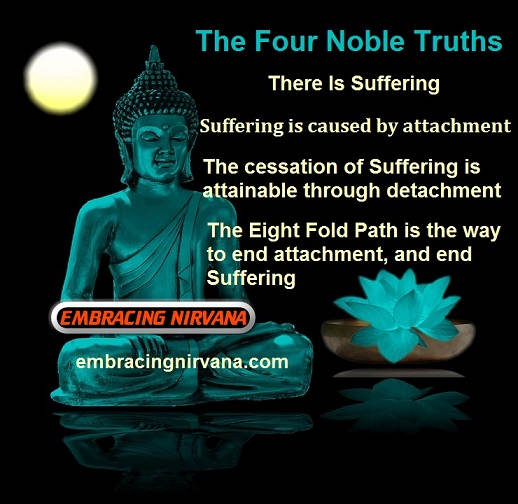The Four Noble Truths:

This post may contain affiliate links. This means that if you click on one of our links and make a purchase, we will receive a commission at no extra cost to you. See our full affiliate disclosure HERE Buddha reached enlightenment while meditating underneath a Bodhi tree. It was there that he envisioned his doctrine of The Four Noble Truths, and The Eightfold Path which are the basis of Buddhism.
The Four Noble Truths:
1. The truth of suffering (Dukkha) There is suffering. Life is suffering.
2. The truth of the cause of suffering. (Samudaya) Suffering is caused by our attachment to desires.
3. The truth of an end to suffering. (Nirhodha) Suffering can be overcome, and happiness attained by overcoming attachment to desires.
4. The truth of the Eightfold path that frees us from suffering. (Magga) Following the steps outlined in the Eightfold Path is the way to end attachment, and end our suffering.
The First Noble Truth:

Dukkha is a word in the Pali language that refers to anything that is unpleasant, and causes us to suffer. It also includes the negative emotions in life such as, distress, sorrow, grief, and pain both mental, and physical as well.
Buddha’s first Noble Truth is that life is suffering. All of us humans suffer in one way or another. ‘All beings have their suffering. Some suffer too little, some suffer too much.” ~Buddha
Birth is suffering. When we are born we awaken into a physical reality born into the confines of a physical body. Our bodies feel physical pain, and we of course experience emotional pain as well. The one person who also suffers during our birth is our mother of course.
Sickness is suffering. We all will become sick at some point in our lives from a simple cold to more serious diseases.
Death is suffering. There is also suffering in our deaths as well. This suffering stems from both the physical pain, and the emotional pain from not knowing what lies beyond deaths door and awaits us on the other side.
The answers as to why we suffer can be found in Buddha’s second noble truth.
The Second Noble Truth:
Samudaya is a Pali word that simply means that the cause of our suffering is our attachment to desires. (Tanha)
Our insatiable attachment to things that we desire is the cause of our suffering. According to Buddha our suffering is caused by not letting go of that which we cling to. We as human beings chose to desire something more, and these desires are often based inside of the physical reality that we believe to be true.
We in mass seem to forget that we are not physical beings, but spiritual beings trapped inside physical bodies. We base our desires on the physical reality that we believe to be true, instead of the reality that we have merely forgotten.
We all are guilty of this attachment to physical reality. If we want to end our suffering we must let go of the reality here in the physical that we believe to be true, and embrace the truth.
If we were not so vehemently attached to that which we desire we would have no negative emotion attached to losing that which we desire. Are you attached to material needs, sensual pleasure, and the desire to have more for yourself here in your perceive physical reality? Let them go, and end your suffering.
Buddha spoke of our ignorance of the power that desire has over us. When we begin to understand that are desires are the root cause of our suffering we are ready for the third noble truth.
The Third NobleTruth:
Buddha’s third Noble truth teaches us that there is a path to freedom from suffering. (Nirhodha) The path to enlightenment starts with letting go of that which you are afraid to lose. All things are impermanent, and no thing, or situation will last forever.
From the first three Noble Truths we have now come to understand that life is suffering, and the cause of our suffering is ignorance, and attachment to desires.
We have learned from Buddha that there is a path to enlightenment, and freedom from suffering. One who has reached enlightenment has successfully released themselves from all of their desires, cravings, and attachments.
The steps that we must take along this path are outlined in Buddha’s Fourth Noble Truth.
The Fourth Noble Truth:
The path that Buddha discovered as a means to end our suffering, and reach enlightenment is known as the middle path. It is the path between the two extremes of absolute luxury, and the path of Asceticism which is the act of renouncing all forms of indulgence.
The middle path is the Eightfold Path that leads to Nirvana.
The Eightfold Paths are:
1. Right understanding: The wisdom to know ourselves, and everything that is around us.
2. Right Thought: Your thoughts as well as your intentions must be positive and pure.
3. Right Speech: The words you speak must be of a compassionate, positive, and uplifting nature when speaking to others, and to yourself.
4. Right Action: Your actions must be carried out in a compassionate and helpful way, not hurtful to any.
5. Right Livelihood: Earning your living in an honest way without cheating others.
6. Right Effort: You must put your energy and effort into achieving wholesome states.
7. Right Mindfulness: We must be fully aware of what we are doing, and focus our thoughts on the present moment.
8. Right Concentration: This is often associated with meditation, and training to focus our attention on just one single thing.
See also... The Law of Impermanence
Come see, and follow Embracing Nirvana on Facebook
Related Articles :
Who was Buddha?The Eightfold Path
60 Enlightening Buddha Quotes
Enlightened T-Shirts

